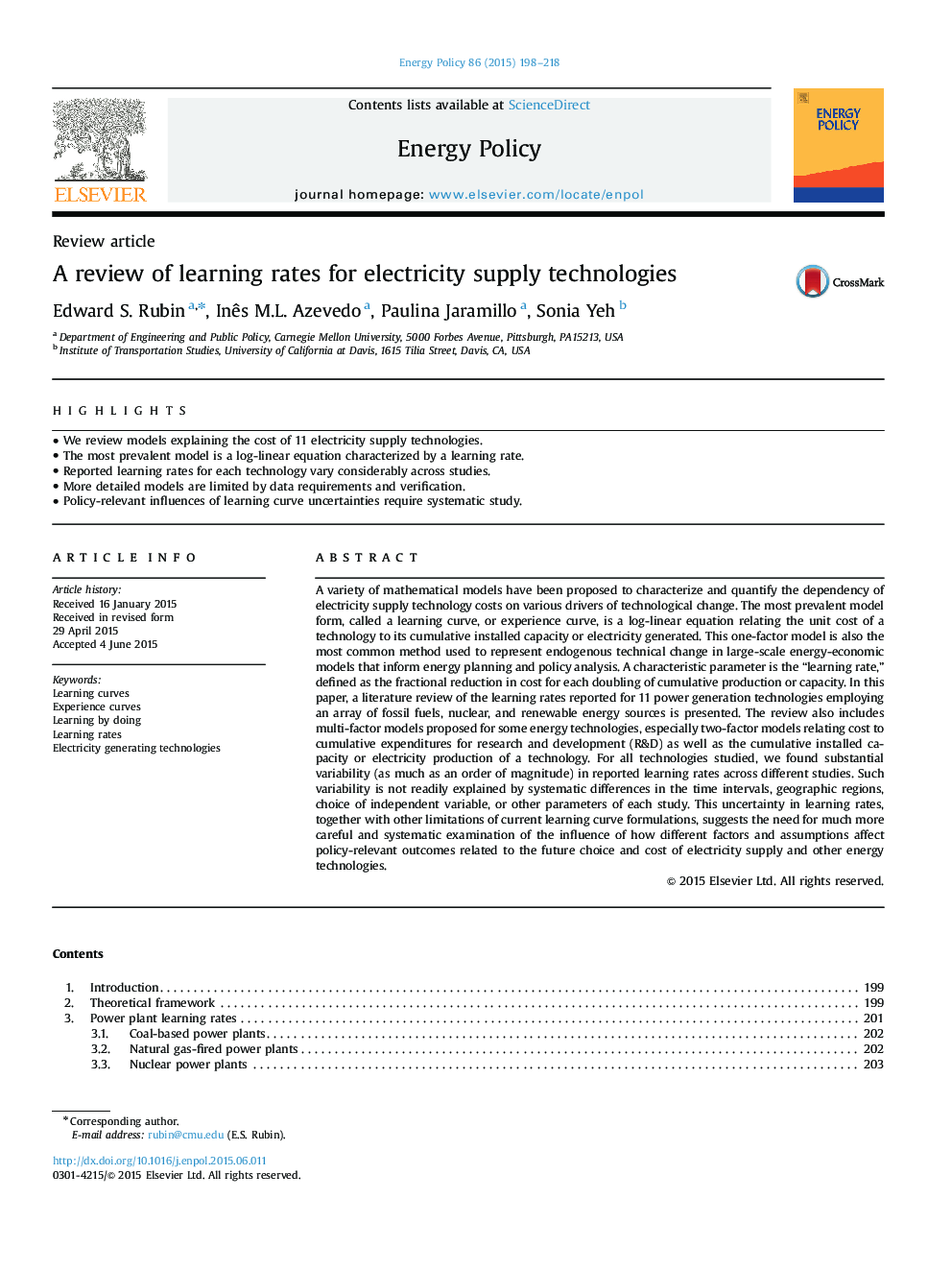| کد مقاله | کد نشریه | سال انتشار | مقاله انگلیسی | نسخه تمام متن |
|---|---|---|---|---|
| 7400154 | 1481272 | 2015 | 21 صفحه PDF | دانلود رایگان |
عنوان انگلیسی مقاله ISI
A review of learning rates for electricity supply technologies
ترجمه فارسی عنوان
بررسی میزان یادگیری فناوری های عرضه برق
دانلود مقاله + سفارش ترجمه
دانلود مقاله ISI انگلیسی
رایگان برای ایرانیان
کلمات کلیدی
منحنی یادگیری، منحنی های تجربه، یاد گرفتن به کمک انجام دادن، نرخ یادگیری، تکنولوژی تولید برق
ترجمه چکیده
انواع مدل های ریاضی برای مشخص کردن و تعیین وابستگی هزینه های تکنولوژی تامین برق به راننده های مختلف تغییر تکنولوژی پیشنهاد شده است. شایع ترین شکل مدل، به نام منحنی یادگیری، یا منحنی تجربه، یک معادله خطی ورودی است که مربوط به هزینه واحد تکنولوژی به ظرفیت نصب شده تجمعی یا تولید برق است. این مدل یک فاکتور همچنین رایج ترین روش برای نشان دادن تغییرات فنی درونی در مدل های اقتصادی انرژی بزرگ است که برنامه ریزی انرژی و تجزیه و تحلیل سیاست را دربرمی گیرد. یک پارامتر مشخص یک نرخ یادگیری است. تعریف شده به عنوان کاهش کسری در هزینه برای هر دو برابر تولید تجمعی و یا ظرفیت. در این مقاله، یک بررسی ادبی از میزان یادگیری گزارش شده برای 11 تکنولوژی تولید انرژی با استفاده از مجموعه ای از سوخت های فسیلی، هسته ای و منابع انرژی تجدید پذیر ارائه شده است. این بررسی همچنین شامل مدل های چند فاکتور پیشنهادی برای برخی از فناوری های انرژی، به ویژه مدل های دو فاکتور مربوط به هزینه هزینه های تجمعی برای تحقیق و توسعه و همچنین ظرفیت نصب شده تجمعی یا تولید برق یک تکنولوژی است. برای همه فن آوری های مورد مطالعه، تغییرات قابل توجهی (به مقدار تقریبی) در میزان یادگیری گزارش شده در مطالعات مختلف یافت شد. چنین متغیری به وضوح با تفاوت های سیستماتیک در فواصل زمانی، مناطق جغرافیایی، انتخاب متغیر مستقل یا پارامترهای دیگر هر مطالعه توضیح داده نمی شود. این عدم قطعیت در نرخ یادگیری، همراه با محدودیت های دیگر از فرمولاسیون فعلی یادگیری یادگیری، نیازمند بررسی بسیار دقیق و سیستماتیک از تأثیر چگونگی تاثیر عوامل مختلف و فرضیه ها بر پیامدهای مربوط به سیاست مربوط به انتخاب آینده و هزینه برق است و دیگر فن آوری های انرژی.
موضوعات مرتبط
مهندسی و علوم پایه
مهندسی انرژی
مهندسی انرژی و فناوری های برق
چکیده انگلیسی
A variety of mathematical models have been proposed to characterize and quantify the dependency of electricity supply technology costs on various drivers of technological change. The most prevalent model form, called a learning curve, or experience curve, is a log-linear equation relating the unit cost of a technology to its cumulative installed capacity or electricity generated. This one-factor model is also the most common method used to represent endogenous technical change in large-scale energy-economic models that inform energy planning and policy analysis. A characteristic parameter is the “learning rate,” defined as the fractional reduction in cost for each doubling of cumulative production or capacity. In this paper, a literature review of the learning rates reported for 11 power generation technologies employing an array of fossil fuels, nuclear, and renewable energy sources is presented. The review also includes multi-factor models proposed for some energy technologies, especially two-factor models relating cost to cumulative expenditures for research and development (R&D) as well as the cumulative installed capacity or electricity production of a technology. For all technologies studied, we found substantial variability (as much as an order of magnitude) in reported learning rates across different studies. Such variability is not readily explained by systematic differences in the time intervals, geographic regions, choice of independent variable, or other parameters of each study. This uncertainty in learning rates, together with other limitations of current learning curve formulations, suggests the need for much more careful and systematic examination of the influence of how different factors and assumptions affect policy-relevant outcomes related to the future choice and cost of electricity supply and other energy technologies.
ناشر
Database: Elsevier - ScienceDirect (ساینس دایرکت)
Journal: Energy Policy - Volume 86, November 2015, Pages 198-218
Journal: Energy Policy - Volume 86, November 2015, Pages 198-218
نویسندگان
Edward S. Rubin, Inês M.L. Azevedo, Paulina Jaramillo, Sonia Yeh,
